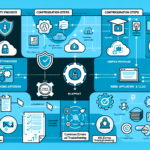Managing certificate lifecycles in an IT infrastructure is critical to ensuring security, compliance, and system reliability. Certificates, such as SSL/TLS certificates, enable secure communication and authentication. Here’s how you can effectively manage their lifecycle:
1. Understand the Certificate Lifecycle
The typical certificate lifecycle includes the following stages:
– Request: Generate a Certificate Signing Request (CSR) and submit it to a Certificate Authority (CA).
– Issue: The CA issues the certificate.
– Deploy: Install the certificate on the appropriate devices, servers, or applications.
– Monitor: Regularly check the certificate’s validity and expiration date.
– Renew: Renew or replace the certificate before it expires.
– Revoke: Revoke the certificate if it is compromised or no longer needed.
2. Use a Centralized Certificate Management Tool
Managing certificates manually is error-prone and inefficient. Use a dedicated certificate management tool, such as:
– Open Source: Certbot, Smallstep
– Enterprise-Grade: Venafi, DigiCert CertCentral, Microsoft Active Directory Certificate Services (ADCS)
– Kubernetes: Cert-Manager for automating certificate issuance and renewal.
These tools can:
– Automate certificate renewals.
– Provide a dashboard to track expiration dates.
– Trigger alerts for expiring certificates.
– Integrate with monitoring tools like Nagios, Zabbix, or Prometheus.
3. Standardize Certificate Policies
Define and enforce standard policies for certificate usage:
– Set minimum key lengths (e.g., 2048-bit for RSA or higher).
– Use modern cryptographic algorithms (e.g., SHA-256).
– Define expiration periods (e.g., 1 year for SSL/TLS certificates).
– Restrict self-signed certificates to development environments.
4. Automate Certificate Management
Automation reduces human errors and ensures timely renewals. Some key methods include:
– ACME Protocol: Use ACME (e.g., with Let’s Encrypt) to automate issuance and renewal.
– Scripts: Create custom scripts to monitor, renew, and deploy certificates.
– Integration: Use APIs from your CA to automate certificate requests and renewals.
For Kubernetes, set up Cert-Manager to automate certificate provisioning and renewal within your clusters.
5. Implement Certificate Monitoring
Set up proactive monitoring to avoid expired or misconfigured certificates:
– Use tools like SSL Labs, Nagios, or custom scripts to monitor certificate validity.
– Integrate with your SIEM (Security Information and Event Management) solution to log certificate-related events.
– Configure alerts to notify your team before certificates expire (e.g., 30-60 days in advance).
6. Manage Certificate Inventory
Maintain an up-to-date inventory of all certificates in your infrastructure:
– Use scanning tools (e.g., Qualys SSL Labs, Nessus) to discover all certificates.
– Track certificates across servers, storage devices, VPNs, Kubernetes clusters, load balancers, and IoT devices.
– Store metadata such as expiration dates, key lengths, issuing CA, and deployment location.
7. Integrate with Configuration Management
Leverage configuration management tools like Ansible, Puppet, or Chef to deploy and update certificates consistently across your infrastructure. This ensures uniformity and reduces manual effort.
8. Follow Security Best Practices
- Use separate certificates for internal and external services.
- Enforce strict access controls for private keys.
- Regularly audit your certificates to identify weak encryption or expired certs.
- Revoke compromised certificates immediately.
9. Plan for Certificate Renewal and Revocation
- Renewal: Automate renewal processes and test them in staging before deploying.
- Revocation: Use CRLs (Certificate Revocation Lists) or OCSP (Online Certificate Status Protocol) to ensure revoked certificates are not trusted.
10. Educate Your Team
Train your team on the importance of certificate management and how to handle certificates securely. Ensure they understand the risks of expired or misconfigured certificates.
11. Leverage HSMs for Key Management
For critical certificates, use a Hardware Security Module (HSM) to securely store and manage private keys. This adds an additional layer of security.
12. Monitor Emerging Trends and Updates
Stay informed about new certificate standards, vulnerabilities, and best practices. For example:
– Transitioning from RSA to ECDSA or post-quantum cryptography.
– Enforcing HTTPS everywhere.
By implementing these practices, you can ensure the effective management of certificate lifecycles, reduce the risk of outages or security incidents, and maintain a secure IT infrastructure.



